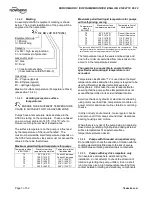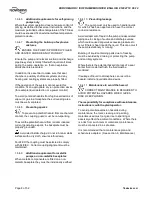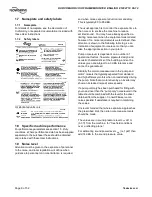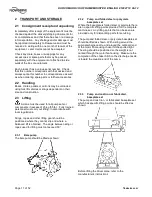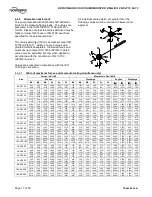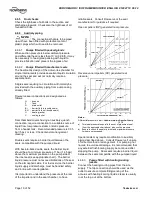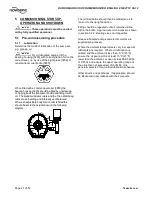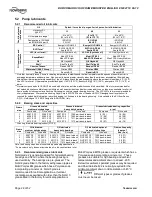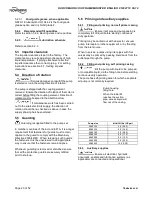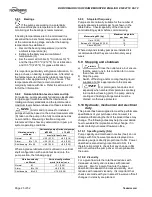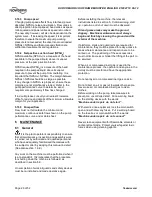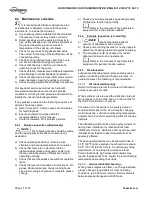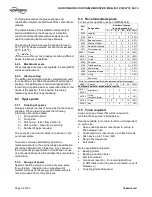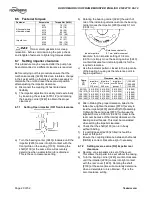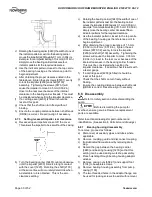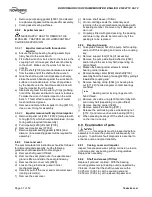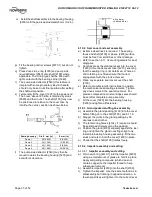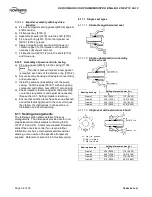
DURCO MARK 3 ISO FRAME MOUNTED ENGLISH 85392719 06-12
Page 19 of 52
flowserve.com
4.6.5
Final checks
Check the tightness of all bolts in the suction and
discharge pipework. Check also the tightness of all
foundation bolts.
4.6.6
Auxiliary piping
The connections that are to be piped
up will have been fitted with protective metal or
plastic plugs which will need to be removed.
Pumps fitted with packed glands
4.6.6.1
When suction pressure is below ambient pressure
and differential head is less than 10 m (32.8 ft), it may
be necessary to feed gland packing with liquid to
provide lubrication and prevent the ingress of air.
Pumps fitted with mechanical seals
4.6.6.2
The Seal Sentry design of the anti-vortex chamber for
single internal seals provides excellent liquid circulation
around the seal and will not normally require a
separate flush.
Single seals requiring re-circulation will normally be
provided with the auxiliary piping from pump casing
already fitted.
Flowserve seal connections are designated as
follows:
Q
- quench
F
- flush
D
- drain outlet
BI
- barrier fluid in (double seals)
BO - barrier fluid out (double seals)
H
- heating jacket
C
- cooling jacket
Seal chambers/covers having an auxiliary quench
connection, require connection to a suitable source of
liquid flow, low pressure steam or static pressure
from a header tank. Recommended pressure is 0.35
bar (5 psi) or less. Check General arrangement
drawing.
Double seals require a barrier liquid between the
seals, compatible with the pumped liquid.
With back-to-back double seals, the barrier liquid
should be at a minimum pressure of 1 bar (14.5 psi)
above the maximum pressure on the pump side of
the inner seal (see appropriate chart). The barrier
liquid pressure must not exceed limitations of the seal
on the atmospheric side. For toxic service the barrier
liquid supply and discharge must be handled safely
and in line with local legislation
It is important to understand the pressure at the rear
of the impeller and in the seal chamber, to have
reliable seals. Consult Flowserve or the seal
manufacturer for guidance if required.
Open impellers (OP) generated rear pressure:
Reverse vane impellers (RV) generated rear
pressure:
Notes:
Differential pressure in bar = Head in meters x Specific Gravity
10.19
a) Total seal pressure is equal to the sum of pressure at seal
(from the applicable chart above) plus suction pressure.
b) Ensure to check the seal minimum and maximum pressure
limits are not exceeded.
Special seals may require modification to auxiliary
piping described above. Consult Flowserve if unsure
of correct method or arrangement. For pumping hot
liquids, to avoid seal damage, it is recommended that
any external flush/cooling supply be continued after
stopping the pump. Dual seals require a barrier liquid
between the seals compatible with the pumped liquid.
Pumps fitted with heating/cooling
4.6.6.3
jackets
Connect the heating/cooling pipes from the site
supply. The top connection should be used as the
outlet to ensure complete filling/venting of the
annulus with heating/cooling liquids; steam is usually
in at the top, out at the bottom.
Summary of Contents for Durco Mark 3
Page 49: ...DURCO MARK 3 ISO FRAME MOUNTED ENGLISH 85392719 06 12 Page 49 of 52 flowserve com Notes ...
Page 50: ...DURCO MARK 3 ISO FRAME MOUNTED ENGLISH 85392719 06 12 Page 50 of 52 flowserve com Notes ...
Page 51: ...DURCO MARK 3 ISO FRAME MOUNTED ENGLISH 85392719 06 12 Page 51 of 52 flowserve com Notes ...



